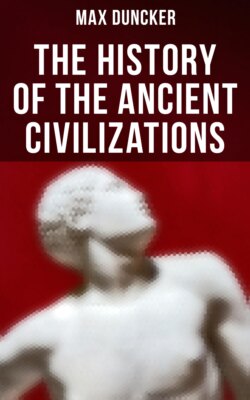Читать книгу The History of the Ancient Civilizations - Duncker Max - Страница 24
На сайте Литреса книга снята с продажи.
FOOTNOTES:
Оглавление[306] Xenoph. "Cyrop." 7, 5; Strabo, pp. 41, 84, 544, 736, 737.
[307] Strabo, p. 748; Xenoph. "Anab." 1, 5, 1 ff.; G. Hertzberg, "Feldzug der Zehntausend," s. 139 ff.
[308] Beros. ap. Sync. p. 28; Herod. 1, 193; "Anab." 2, 3.
[309] Herod. 1, 178–200.
[310] "De Cœlo," p. 503.
[311] Diod. 3, 31; Cic. "De Divin." 1, 19; Jul. Afric. ap. Syncell. p. 17; Plin. "Hist. Nat." 7, 57; cf. H. Martin, "Revue Archéol." 1862, 5, 243.
[312] Between 280–270 B.C. Clinton, "Fasti Hell." ad ann. 279.
[313] Abydeni Fragm. 9, ed. Müller.
[314] Berosi Fragm. 1, ed. Müller.
[315] Abyd. Fragm. 1, 2, ed. Müller; Berosi Fragm. 5.
[316] In the Armenian Eusebius, p. 10, ed. Schœne, the name is Lancharis.
[317] G. Smith, "Bibl. Arch." 3, 531.
[318] So in the Armenian Eusebius; in Syncellus it is five stadia, i.e. 3,000 feet long.
[319] Eusebius, p. 14, ed. Mai; Syncell. p. 30; Abydeni Fragm. 3 ed. Müller; Lucian, "De Dea Syria," 12.
[320] Eusebius gives 33,091. As Syncellus enumerates the sares, neres, and sosses, the number given in the text is the correct one, or must be replaced by 34,091. The basis of the calculation which Syncellus has adopted in the four first dynasties of Berosus has been thoroughly established by Lepsius ("Chronol. der Ægypter," s. 78).
[321] The period of the fourth dynasty, the eleven kings, is filled up to 248 years from the marginal note on the Armenian manuscripts of Eusebius.
[322] G. Smith, "Assyrian Discoveries," p. 185–195. I retain the reading "Sisit" as against Hasisadra because of the "Sisythes" of Lucian.
[323] According to Bunsen, "Ægypt." 5, 2, 61 ff., the Hebrews originally were acquainted with only seven patriarchs before the flood; see below.
[324] Gen. ix. 20, 28; xi. 2–9.
[325] Plin. "Hist. Nat." 6, 30. Hipparenum can be nothing but Sipparenum, or Sipparenorum.
[326] If the number 34,091 be correct (p. 241, note 2), the year 2447 B.C. would be the first year of the historical era.
[327] It is pointed out by Von Gutschmid in the Rhein. Mus. 8, 252.
[328] Gen. x. 22; x. 8, 10.
[329] Menke, "Jahrb. für classiche Philologie," 1862, s. 545.
[330] Aesch. "Pers." 16.
[331] The name Nanchundi occurs also in the compounds Istar-Nanchundi, p. 253.
[332] G. Smith, "Assurbanipal," p. 200, 234–236, 249–251. As in two passages 1,635 years are given with quotation of the Neres and Sosses, this number must be kept in the third passage instead of 1,535 years. The conquest of Susa did not follow immediately on the conquest of Babylon, in the year 647; see below.
[333] Sayce, "Bibl. Arch." 3, 479; Oppert, "Empires de Chaldée et d'Assyrie," p. 27.
[334] G. Smith, "Discov." p. 234; "Early Hist." p. 58.
[335] Genesis, xiv. 1–12; G. Smith, "Assurb." p. 228.
[336] Also in Ménant, "Les Achémenides," p. 136.
[337] G. Smith, "Assurbanipal," p. 224, ff.
[338] Sayce, "Transact. Bibl. Arch." 3, 465, 485.
[339] So Rawlinson, Norris, Mordtmann, "Zeitschrift d. d. M. G." 1870, s. 7, 76, and Sayce, loc. cit.
[340] Norris, "Dict." I. 50.
[341] Such is also the opinion of Eberhard Schrader.
[342] Schrader, "Abstammung und Ursitze der Chaldæer," s. 405 ff., 416 ff.
[343] Strabo, p. 735, 765, 767; Pliny, "Hist. Nat." 6, 23, 27. 5, 20.
[344] On the correct interpretation of the passage, Isaiah xxiii. 13, see Schrader, "Keilschriften und Alt. Test." s. 269; on the Armenian Chaldæans, the Chalybian Chaldæans, Schrader, "Abstammung der Chaldæer," s. 399, 400. The former are to be sought for in the valley of the Lycus, and are known to the Armenians as Chalti: Kiepert, "Monats-Berichte der B. Akad. d. W." 1869. Arphaxad, i.e. the high mountain district Albak (Kiepert, loc. cit. s. 200), on the Upper Zab, was on the other hand undoubtedly colonised by Semitic tribes; but these probably came from Mesopotamia and Assyria. Arphaxad is the younger brother of Elam and Asshur. Where to look for Kir, whence, according to Amos ix. 7; i. 5, the Syrians came, we do not know.
[345] Schrader, "Assyrisch-babyl. Keilschriften," s. 382, 18, 42, 165, 225.
[346] Schrader, "Keilschriften und Alt. Test." s. 383.
[347] Oppert, "Inscript. des Sargonides," p. 55 ff.
[348] Above, pp. 132, 151, 152. From Naharina Tuthmosis III. received, among other things, forty-seven tiles of lead, forty-five pounds of gold, eighty-one mana (minæ) of spice.—De Rougé, "Notice," pp. 16, 18.
[349] Oppert, "Empires," pp. 16, 17; G. Rawlinson, "Five Monarchies," 1, 63, 64, 137; Ménant, "Babylone," pp. 74, 75, 254.
[350] G. Smith, "Early History," p. 36; G. Rawlinson, "Five Monarchies," pp. 69, 94, 157 ff.
[351] Oppert, "Empires," p. 21.
[352] Schrader, "Keilsch. und Alt. Test." s. 47; "Assyrisch-babylonische Keilschriften," s. 162; Sayce, "Zeitschrift für ægypt. Sprache," 1870, s. 151; Ménant, "Babylone," p. 98.
[353] Oppert, "Empires," p. 36.
[354] Lenormant, "Lettres Assyr." 1, 249.
[355] Oppert, "Empires," p. 28; Ménant, "Babylone," pp. 118, 121.
[356] G. Rawlinson, "Five Monarchies," pp. 169, 170.
[357] G. Smith, "Discov." p. 236 ff., gives a deed of gift of Merodach-Baladan, the son of Milihiru, the grandson of Kurigalzu.
[358] Ménant, "Babylone," pp. 127, 128.
